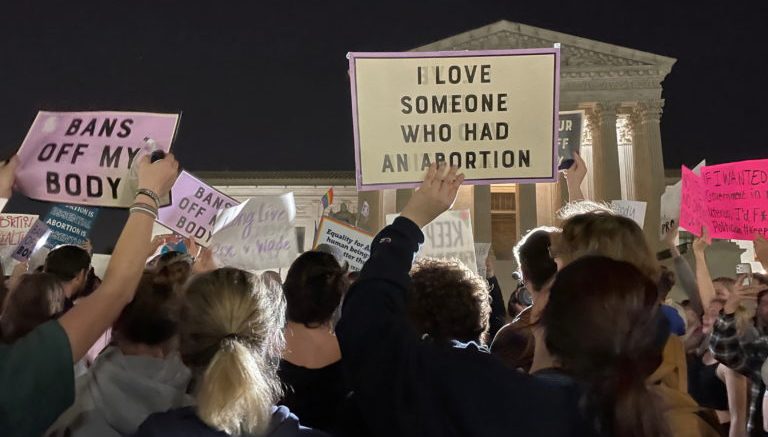If you are frequent on any form of social media, there is a guarantee that within 3 minutes of scrolling through, you have seen something relating to the overturning of Roe v. Wade. This might entail what Roe v. Wade is, the problems it has caused, why it is unfair, etc. If we are being honest, the conversation isn’t going to end, so you might as well catch up.
What is Roe v. Wade?
The discussion sparked in 1970 when someone under the pseudonym Jane Roe filed a lawsuit against Henry Wade, the district attorney for Dallas County in Texas. She challenged the Texas Law that women are only allowed to receive an abortion on a doctor’s word to save their life by saying it breached the privacy law under the 1st, 4th, 5th, 9th, and 14th Amendments. More importantly, the Due Process Clause under the 14th Amendment protects women against the state’s interference in privacy, which a women’s choice to have an abortion falls under. The whole case resulted in an astounding 7-2 decision (7 agreeing with Roe) and the creation of a timetable that decides when the state’s interference is just. During a pregnant woman’s first trimester, the state has no say, only the woman and the physician. During the second trimester, the state may impose regulations on abortion that are reasonably associated with the woman’s health. During the third trimester, the state can impose rules and stop them entirely unless it affects the woman’s well-being.
Another result was that since the right to abortions was now considered fundamental, it went under strict scrutiny when challenged in court. That being said, the court essentially decides whether the law should give way to the government’s interest against the observance of the principle (the government must also have an interest in the law). All of this did not sit well with the public. Some believed Roe achieved something great and just dealt with the issue poorly. In contrast, others said this was a part of judicial activism (judges making decisions with their views and considering societal implications instead of sticking with just law). Other activists thought Roe didn’t push the supreme court far enough and the government could have done more work. Since then, many other cases have sparked from Roe v. Wade, for example, Planned Parenthood v. Casey which reaffirmed Roe. v. Wade, but also switched strict scrutiny to undue burden (legislatures cannot make a particular law that is too restrictive of one’s fundamental rights). With laws discussing human rights, pushback and arguments are bound to occur, bringing us back to the present day.
What is the Overturning of Roe v. Wade?
To start, here’s a quote from Justice Samuel Alito, who “summed” up the court majority saying, “must be overruled” because they were “egregiously wrong,” the arguments “exceptionally weak” and so “damaging” that they amounted to “an abuse of judicial authority.” Thirteen states had trigger ban laws already in place, meaning abortions were set to be illegal soon after. Eight of those states had them instated the same day. Thirteen other states were expected to follow soon after. Currently, 15 states have abortions completely banned or nearly with no exceptions to rape or incest. Six states have courts now blocking bans while decisions are being changed and finalized. Nine states have abortions written down as legal but have these laws currently under threat of being revoked. Looking up, though, 20 states have abortion laws protected and legal. Again coming from Alito, their justification for leaving it up to the states is to prevent “gruesome and barbaric” medical procedures; to “preserve the integrity of the medical profession,” and to prevent discrimination on the basis of race, sex, or disability, including barring abortion in cases of fetal abnormality.” Simply put, the state can ban abortions for any reason its heart desires. The issue is summed up by Justice Thomas, “high court should revisit all cases built on similar legal footing—including cases that guarantee the right to contraception, same-sex consensual sexual relations, and same-sex marriage.”
The U.S. House reapproved same-sex marriage in July of 2022 after the released decision of Roe v. Wade. Even as abortion rights are being overturned, Senate Democrats have decided to postpone the voting until after the midterms to secure and protect its passing amid the current evenly split Senate. During the initial ballot in the House, 2/3 of the Republican party voted against gay marriage. Lauren Boebart, a U.S. State Representative, claimed the Equality Act was supremacy for “gays, lesbians, and transgender people.” Some Republicans were relieved with this decision because those who disagreed were worried that voting against it so close to the elections would turn away voters. With same-sex marriage up for grabs, what else is at stake?
How this affects the LQBTQIA+
As mentioned previously, the laws for same-sex marriage were immediately pushed into the spotlight after the overturning of Roe v. Wade. With the justification of making abortions a state decision, many worry that Obergefell v. Hodges will be next. With Alito and Justice Clarence Thomas hinting at their willingness to reverse it, the worriedness is justified.
Cathryn Oakley, an attorney with the Human Rights Campaign, states, “The LGBTQ community relies on reproductive health care. LGBTQ people seek and receive abortions, they seek and receive and use contraception.” Access to contraception can become scarce, especially in states where abortions are illegal. Companies such as Planned Parenthood and fertility centers have the possibility of running out of business and resources, leaving many people at a considerable disadvantage. Secondly, LGBTQ people rely on assisted reproduction like in vitro fertilization(IVF), and the law’s current standpoint—human life begins at conception—makes the embryos in that petri dish (legally) people. This thought makes IVF impossible and potentially illegal.
Clinics that provide abortions are also most likely to offer gender-affirming products and healthcare to trans individuals who may be at a loss anywhere else. These include hormones, puberty blockers, and other forms of contraception. Within the first four months of 2022, nearly 300 anti-LGBTQ bills were filed, most of which attacked those of the trans community. Alabama, for example, is now the first state to add felony charges to those who practice altering or affirming a minor’s sexual identity. With portions of their health care, such as contraceptives, already being ripped to shreds by state lawmakers, removing their right to gender-affirming products is the last thing needed.
Miscarriages and Reproductive Health
Miscarriages are already being impacted in states like Texas. In clinics, the standard care for treating a miscarriage is the same as treating an abortion. When someone has a miscarriage, the medication used to empty their uterus to prevent infection is the same medication used in medical abortions. In Texas, hundreds of reports have been filed against pharmacies not filling these drugs to women suffering miscarriages. For instance, a woman in Texas was grilled with questions regarding what medications she may have taken and how her miscarriage happened. The constant blame of women for miscarriages is not new, but to be refused medications is a new level of obscurity.
No medical condition is black or white, and abortion laws make practicing medicine more dangerous for patients. For example, suppose they develop a condition like preeclampsia, which puts women at very high risk for stroke. In that case, they cannot get an abortion and must continue the pregnancy despite it being life-threatening to the expecting mother. Unfortunately, in 2012, a woman named Savita Halappanavar had her water break prematurely. Because the fetus still had a heartbeat, she was denied an abortion. Sadly, she developed an infection and died, spurring the legalization of abortion in Ireland. To further, patients in states that do not allow the termination of pregnancy for lethal fetal anomalies may have to carry the pregnancy to term, causing physical and mental damage.
Real-Life Examples
First is the story of Marlena Stell. Marlena was going into a prenatal ultrasound when doctors discovered she suffered from fetal demise (her pregnancy was no longer viable). Having gone through this before, she asked for a D&C procedure which is the standard procedure during abortions and miscarriages to prevent infections. She was refused this procedure because, under the new Texas state abortion law, you must get a second opinion (this time transvaginally) from a different location to ensure there isn’t a heartbeat doctors missed. Despite not wanting to be told her baby was no longer viable once again, she did go to get a second ultrasound. Afterward, she was told again that Texas state law requires her to complete a third ultrasound at a new location. This took over two weeks, but she eventually found a provider who would complete the procedure only after being harassed by protesters outside of every clinic she went to. After the hell she was put through, she took her story to the internet to share the troubles and complications of being forced to carry dead fetal tissue for more than two weeks sparking an outcry in many neighboring states.
Another comes from a Texas doctor who had a woman come in as a patient presenting with early onset sepsis from a uterine infection caused by an ongoing miscarriage. Unfortunately, the fetus still had a heartbeat, so under Texas law, doctors were prohibited from interfering until the heartbeat ended. Twenty-four hours later, doctors could finally perform the surgery she needed. However, due to complications and the now high-risk surgery, she was forced to be put on a ventilator and was eventually pronounced brain-dead two months later. Even though this was back in 2014, what was a situation in one state is now a possibility everywhere.
Takeaways
Roe v. Wade is not the simple law that the news makes it out to be. Roe v. Wade is the right not to be prosecuted for a miscarriage. Roe v. Wade protects the right to a C-section. Roe v. Wade protects LQBTQ parents from discrimination. Roe v. Wade protects disabled people, stillbirths, and imprisonment for a woman who cannot carry her baby to term due to life-threatening illnesses. Roe v. Wade is not something that can be overturned without consequences, and the world cannot ignore that fact any longer.






Be the first to comment on "The Repercussions of Roe v. Wade"